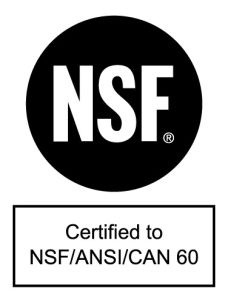Use DRY ACID SPECIAL to:
- dissolve limestone, hard-water scale, rust and corrosion deposits.
- keep dissolved solids in suspension more efficiently than other mineral acids improving well rinse-out.
- develop new wells producing from limestone or calcareous sand and gravel formations.
- redevelop old wells that have hard-water scale, rust or corrosion deposits plugging the perforations, screen or formation.
How to use DRY ACID SPECIAL:

Use 3/4 to 1 lb. of DRY ACID SPECIAL per gallon of water in the well. (See table) If you are acidizing the formation and the well is gravel-packed, displace the acid back through the gravel wall by surging or adding water equal to about 3/4 the volume of water standing in the hole. In new wells the displacement should occur soon after all the acid has been added and thoroughly mixed. In old wells allow the acid to stay in the casing for a few hours before adding the water. Water should be added slowly.
Note: A five percent acid concentration is considered an absolute minimum for effective cleaning.
DRY ACID SPECIAL should remain in the well for 24-36 hours and should be agitated every few hours. If a rig is over the hole agitate with a bailer, surge block or other tool. Dry ice can be used to agitate the chemical if rig or pump are not available.
Pump or bail the hole clean, develop and test. Initial water after treatment contains spent chemicals and should be pumped to waste.
For best results:
- Brush the well with the Cotey well cleaning brush prior to chemical treatment. Brushing the well can remove interior screen deposits ensuring more uniform chemical access into the formation.
- Agitate the well with a tight-fitting surge block or other isolation tool (the Cotey WELL CLEANING BRUSH, for example). This dislodges material softened by the chemical treatment and pushes the chemical solution further into areas it may otherwise not be able to reach.
(note: The combination of both chemical and mechanical energy is important for penetrating and removing the plugging material) - Monitor the pH during acid treatment. When acidizing a water well it is best to check the pH frequently. With pH levels above 3.0 the acid is losing strength and productivity. Check the pH after each agitation. If the pH rises above 3.0 add more acid. This process allows for a more accurate chemical treatment.
How to dispose of DRY ACID SPECIAL:
Waste from DRY ACID SPECIAL treatment should not be pumped to cultivated fields nor made available to livestock. Depending on quantity used and condition of the well treated, waste may be near neutral, to very acidic. Cotey therefore recommends that waste be pumped to sewage, barrow ditches for natural evaporation, or to local pits for evaporation and consequent filling provided infiltration will not contaminate a local aquifer. In all cases waste should be thoroughly diluted. (Local, State and Federal regulations should be adhered to.)
CAUTION:
DO NOT MIX DRY ACID SPECIAL WITH OTHER CHEMICALS!
DRY ACID SPECIAL is primarily an acid. Avoid breathing the dust and flush with water in case of contact. Wash after handling and use with adequate ventilation. For ingestion of sulfamic acid drink large amounts of water, tea, coffee or milk with raw eggs, and secure immediate medical attention.
Store DRY ACID SPECIAL away from chlorine. Do not add chlorine or liquid bleach to wells treated with DRY ACID SPECIAL until the well has been flushed to waste. Chlorides added to sulfamic acid may form nitrogen trichloride (NCl3), an explosive. DRY ACID SPECIAL is fully inhibited and is safe on plastics, rubber and most metals commonly used in water well equipment. It will not harm the pump or well screen. There are no acid fumes, no hazardous carboys, low handling costs, yet there is a rapid decomposition of carbonate scales.
Dry Acid Special is packaged in 10-lbs., 50-lbs. and 600-lbs. containers.

